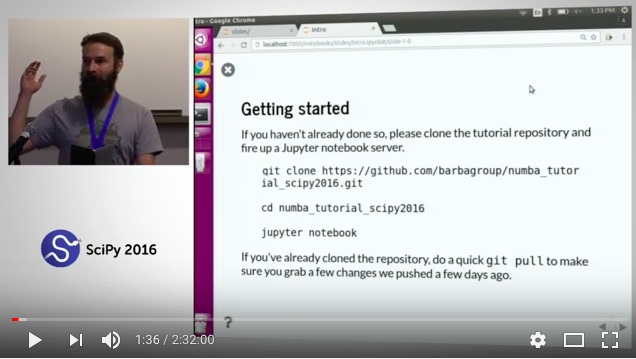barbagroup / Numba_tutorial_scipy2016
Labels
Projects that are alternatives of or similar to Numba tutorial scipy2016
Numba: Tell those C++ bullies to get lost
This is the repository for the Scipy 2016 tutorial. The tutorial will be presented as a set of Jupyter notebooks with exercises sprinkled throughout.
Installation Instructions
We strongly, strongly, strongly encourage you to use conda to install the required packages for this tutorial. There are non-Python dependencies required that make manual installation or installing with pip very involved.
Note also that this tutorial is written for Python 3.5. Most things will still work on Python 3.4. No guarantees of any kind are made that it will be compatible with Python 2.
Regarding matplotlib
This tutorial uses the Viridis colormap pretty much everywhere we can use a colormap. This colormap was first made available in matplotlib 1.5.0. Please upgrade if you have an earlier version installed.
Installing with conda
Option a) Create a new environment
Download the environment.yml file in the root of this repository, e.g.
wget https://raw.githubusercontent.com/barbagroup/numba_tutorial_scipy2016/master/environment.yml
and then create the environment with
conda env create -f environment.yml
This will create a conda environment named numbatutorial with all of the required packages.
You can activate the environment with
source activate numbatutorial
or on Windows:
activate numbatutorial
Option b) Install the required packages
conda install jupyter ipython numpy numba line_profiler matplotlib
pip install line_profiler
Note: Do not use conda to install line_profiler; the version available in conda default channels is out of date.
Installing with pip
To install (specifically) Numba using pip, you need to have LLVM 3.7 installed on your machine with both libraries and header files.
Prerequisites
Ubuntu / Debian
You should be able to do a
sudo apt-get install llvm-3.7-dev
You may also need to install libedit-dev
Windows
You can follow instructions here for getting LLVM installed on Windows.
http://llvm.org/docs/GettingStartedVS.html
OSX
Install XCode which includes LLVM
Install llvmlite
If your llvm-config (or llvm-config.exe) file is in a non-standard location, set the LLVM_CONFIG environment variable to point at the llvm-config binary.
Then
pip install llvmlite
If that installed successfully then you can continue to install the rest of the dependencies (which are must less fussy)
Install everything else
pip install numpy matplotlib jupyter ipython numba line_profiler
or
pip install -r requirements.txt
Optional extras
No hands-on work requires these, but if you want to play with some of the examples. If you installed using either environments.yml or requirements.txt these are already installed.
conda install cython dask
pip install cython dask
We recommend you also install the Jupyter notebook extensions.
pip install https://github.com/ipython-contrib/IPython-notebook-extensions/archive/master.zip --user
Once they are installed, start a notebook server
jupyter notebook
and (assuming port 8888) navigate to http://localhost:8888/nbextensions where you can choose which extensions to enable. One that is helpful (for us!) when using Numba in the notebook is the Skip-Traceback extension. You're welcome to enable whichever extensions you like (we're also fans of Codefolding and the Comment/Uncomment Hotkey).
Check Installation
Once you have downloaded all of the requires libraries/packages, you can run the check_install.py script to confirm that everything is working as expected. Either download the file directly or clone this repository and then run
python check_install.py
Video of the live tutorial
Check out the video of the live tutorial at SciPy 2016 (filmed Monday 11 July).

